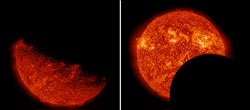NASA’s SDO Observes Earth, Lunar Transits in Same Day

Left: The view of the sun is partially obscured by Earth as seen by NASA’s Solar Dynamics Observatory on Mar. 11, 2013, at 2:20 a.m. EDT. Credit: NASA/SDO<br>Right: This image from NASA’s Solar Dynamics Observatory on Mar. 11, 2013, at 8:00 a.m. EDT, shows the moon crossing in front of the sun. Credit: NASA/SDO<br>
On March 11, however, SDO was treated to two transits. Earth blocked SDO’s view of the sun from about 2:15 to 3:45 a.m. EDT. Later in the same day, from around 7:30 to 8:45 a.m. EDT, the moon moved in front of the sun for a partial eclipse.
When Earth blocks the sun, the boundaries of Earth’s shadow appear fuzzy, since SDO can see some light from the sun coming through Earth’s atmosphere. The line of Earth appears almost straight, since Earth — from SDO’s point of view — is so large compared to the sun.
The eclipse caused by the moon looks far different. Since the moon has no atmosphere, its curved shape can be seen clearly, and the line of its shadow is crisp and clean.
Any spacecraft observing the sun from an orbit around Earth has to contend with such eclipses, but SDO's orbit is designed to minimize them as much as possible, with only two three-week eclipse seasons each year. The 2013 spring eclipse season continues until March 26. The fall season will begin on Sept. 2.
Karen C. Fox
NASA’s Goddard Space Flight Center
Media Contact
All latest news from the category: Physics and Astronomy
This area deals with the fundamental laws and building blocks of nature and how they interact, the properties and the behavior of matter, and research into space and time and their structures.
innovations-report provides in-depth reports and articles on subjects such as astrophysics, laser technologies, nuclear, quantum, particle and solid-state physics, nanotechnologies, planetary research and findings (Mars, Venus) and developments related to the Hubble Telescope.
Newest articles

Webb captures top of iconic horsehead nebula in unprecedented detail
NASA’s James Webb Space Telescope has captured the sharpest infrared images to date of a zoomed-in portion of one of the most distinctive objects in our skies, the Horsehead Nebula….

Cost-effective, high-capacity, and cyclable lithium-ion battery cathodes
Charge-recharge cycling of lithium-superrich iron oxide, a cost-effective and high-capacity cathode for new-generation lithium-ion batteries, can be greatly improved by doping with readily available mineral elements. The energy capacity and…

Novel genetic plant regeneration approach
…without the application of phytohormones. Researchers develop a novel plant regeneration approach by modulating the expression of genes that control plant cell differentiation. For ages now, plants have been the…





















